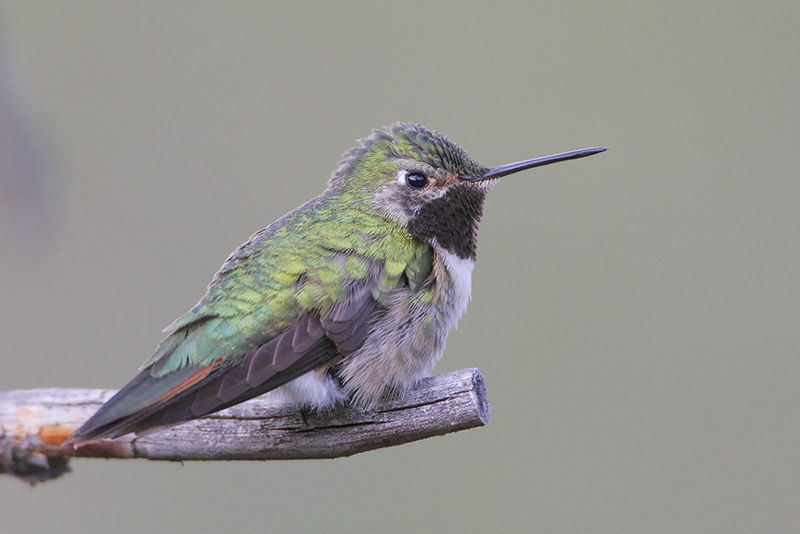
Texas is one of the most exciting states for birding. Hundreds of birds live in Texas, hummingbirds too!
Go birding in Texas and you’ll see several hummingbirds, especially in the southern and western parts of the state. Which hummingbird species live in Texas? Where do they occur?
See answers in this article and more about the hummingbirds of Texas!
The Colorful Hummers in Texas
Since Texas in a southern state, there are lots of exotic birds you might not see in colder states. So, basing our findings on eBird data, we ventured out to find out which hummingbirds you are more likely to see in Texas!
Ruby-throated Hummingbird
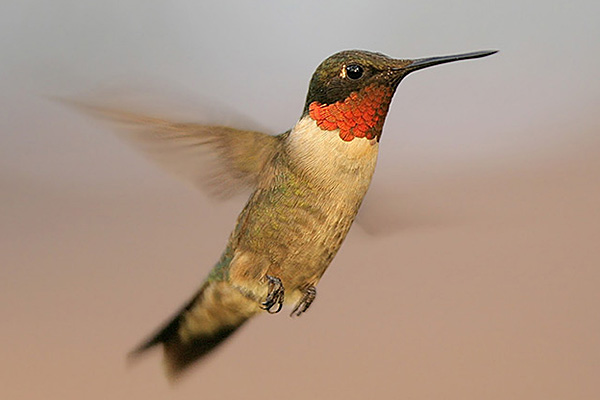
Photograph © Greg Lavaty.
Scientific name: Archilochus colubris
Length: 3.75 inches
Wingspan: 4.5 inches
The Ruby-throated Hummingbird is the common, small hummingbird of eastern North America. Although other, rare species can occasionally occur, at eastern feeders, this species is the de-facto hummingbird.
Males are green above, have some olive on their belly, a white chest and semi-collar, and a tiny white spot behind each eye. True to their name, they also have a beautiful, ruby-red throat. However, as with most hummingbirds, those colors only show in certain lighting.
They also have a dark, slightly forked tail, and a long, needle-like beak. Female Ruby-throated Hummingbirds look quite different from their male counterparts! They are also green above but have a grayish throat, and white tips on their tail.
Ruby-throated Hummingbirds are common in woods, second growth, and gardens near woods from central and southern Canada to Florida and Texas. Although they feed on their own, several can congregate at feeders, especially during migration! They also feed from a wide variety of small flowers.
Key identifications:
- Red throat and white semi-collar.
- Dark, slightly forked tail.
- Females have a white spot behind their eyes, a hint of a dusky mask, and the tail of perched birds is longer than their wingtips.
Black-chinned Hummingbird
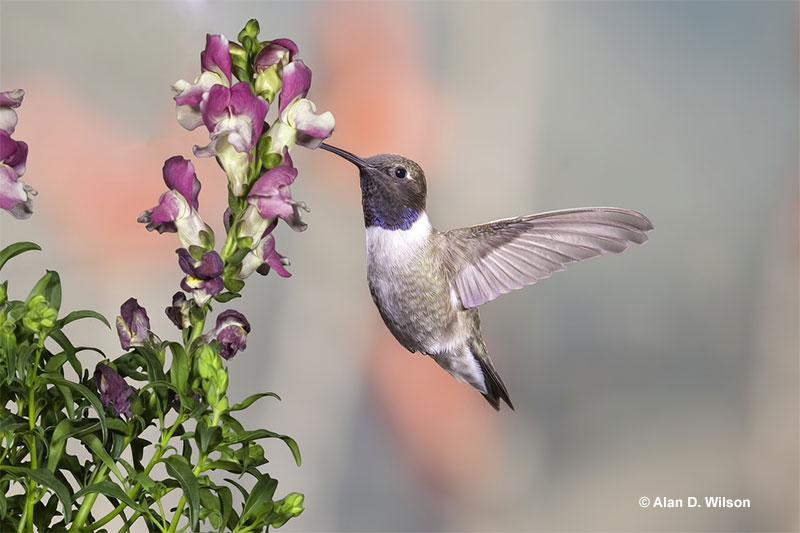
Scientific name: Archilocus alexandri
Length: 3.75 inches
Wingspan: 4.75 inches
Black-chinned Hummingbirds replace the Ruby-throated Hummingbird west of the Rocky Mountains and in parts of central and southern Texas. They are green above and dusky gray below with a white semi-collar and small pale spot behind their eyes.
Males have a beautiful dark purple throat with a black chin, and a black, slightly forked tail. Females have a dusky gray throat, grayish crown, hint of a dark mask, and a slightly forked tail with white tips on the outer tail feathers.
On perched females, the wings nearly reach the end of their tail. These pretty hummingbirds are common at feeders from parts of southern British Columbia to northern Mexico. They also feed from a variety of small tubular flowers and live in riparian zones, brushy habitats, and gardens.
In late summer, Black-chinned Hummingbirds migrate to western Mexico for the winter. However, some also winter at feeders from Louisiana to Florida.
Key identifications:
- Dark throat with a white semi-collar.
- Grayish belly and black, slightly forked tail.
- On females, look for the grayish crown, long, slightly curved beak, and rounded wing tips that nearly reach the end of their tail.
Buff-bellied Hummingbird
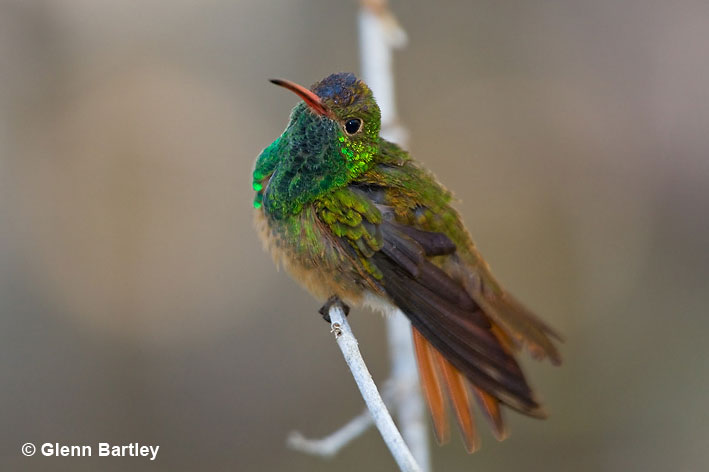
Scientific name: Amazilia yucatensis
Length: 4.25 inches
Wingspan: 5.75 inches
The Buff-bellied Hummingbird is a Mexican species that barely extends into the southern tip of Texas. It’s a common bird of subtropical woodlands and gardens, and also visits feeders. Like several other hummingbird species, feeders in the Gulf Coast region have helped the Buff-bellied Hummingbird expand its range east to Florida.
Although it doesn’t occur east of its normal range all year long, several birds do migrate to that area for the winter months.
Buff-bellied hummingbirds are medium-sized hummingbirds with green upperparts, a green head and throat, and a buff belly. Both sexes look pretty similar and also have red-brown tails, and a slightly curved red beak with a dark tip.
This species is bold and usually easy to see at feeders and flowering plants. Like other hummingbirds, in the early morning, Buff-bellieds also catch tiny insects in flight. Similar to other hummingbird species, they also build small cup nests out of spiderwebs and soft vegetation.
Key identifications:
- Red-brown tail.
- Buff belly and green throat.
- Red beak with a dark tip.
Rufous Hummingbird
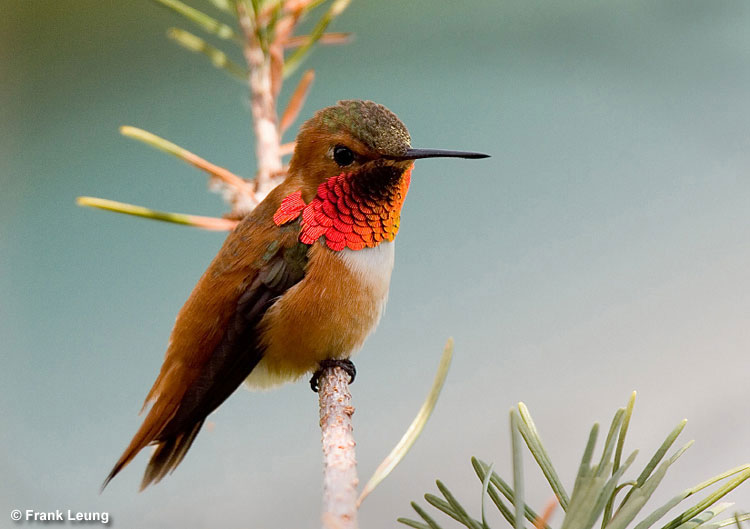
Scientific name: Selasphorus rufus
Length: 3.75 inches
Wingspan: 4.5 inches
Rufous Hummingbirds breed in the coniferous forests of the Pacific Northwest and then fly to central Mexico for the winter. Some even breed as far north as southern Alaska!
Males are pretty, pumpkin orange hummingbirds with white on the upper part of their chest, and an orange-red throat. Some males also have green on their back and crown.
Female Rufous Hummingbirds are green above and white below with pale rufous highlights on their underparts. They also have rufous on the base of their tail, and white tips on their outer tail feathers.
This species often visits feeders but they can also forage at any number of small tubular flowers. Although they are common birds from the Rocky Mountains west to California, several Rufous Hummingbirds also migrate to feeders in various parts of the eastern USA.
Happily, they have become regular at feeders and flowering bushes in coastal areas from Texas to Florida.
Key identifications:
- Pumpkin orange plumage, especially on the back and head.
- Orange-red throat.
- Rufous on the base of their tail and rump, and broad outer tail feathers.
Broad-tailed Hummingbird
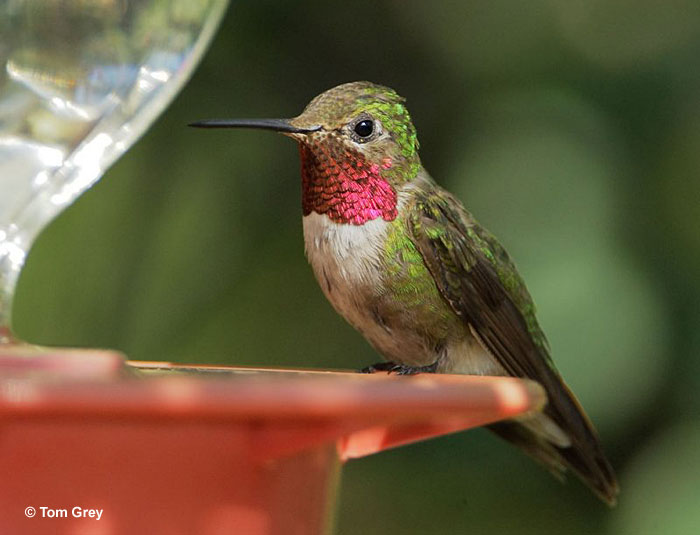
Scientific name: Selasphorus platcercus
Length: 4 inches
Wingspan: 5.25 inches
Broad-tailed Hummingbirds are one of the more common hummingbird species in the Rocky Mountains. If you see a hummingbird while birding in and near the Rockies during the summer months, there’s a good chance it’s a Broad-tailed.
These montane hummingbirds are green above, buffy and green below, have a pale eyering, and a bit of orange on the base of their big, broad tail. Males also have a rose-red throat while females have small spots on their throat.
Like many other hummingbirds, Broad-taileds take nectar from flowering bushes and also visit feeders. They occur higher than most other hummingbirds in North America, even breeding as high as 10,000 feet!
After breeding, Broad-tailed Hummingbirds in the USA migrate to montane habitats in Mexico for the winter. No matter the season, this pretty hummingbird is easy to see.
When visiting the Rockies in summer, listen for the high-pitched twittering sound males make in flight!
Key identifications:
- Rose-red throat with green and buff underparts.
- Pale eyering.
- A bit of orange on the base of its big, broad tail.
Anna’s Hummingbird
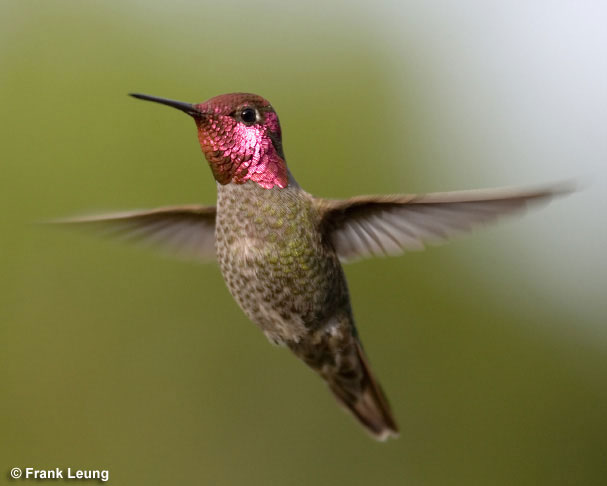
Scientific name: Calypte anna
Length: 4 inches
Wingspan: 5.25 inches
Anna’s Hummingbirds are one of the most common hummingbirds on the west coast. These little beauties live in parks, gardens, and similar habitats from British Columbia to northern Mexico.
Ornamental plantings and gardens have also helped this little bird expand to many parts of Arizona. Anna’s Hummingbirds are dusky green, have straight beaks, and a bit of white above their eyes.
Although females are fairly dull, male Anna’s Hummingbirds have shining fuchsia pink-red on their throat and head. This species is pretty common and easy to see in most of its range.
Like so many other hummingbird species, Anna’s Hummingbirds forage at flowering bushes and feeders. They also catch small insects in flight, especially in the morning and when they are nesting.
In most places, Anna’s Hummingbirds are resident all year long. However, some make movements north and south of their breeding range and some birds have wandered to the easter coast!
Key identifications:
- Males have pink-red on their heads.
- Both sexes have dusky-gray-green underparts.
- White mark above and behind each eye.
Lucifer Hummingbird
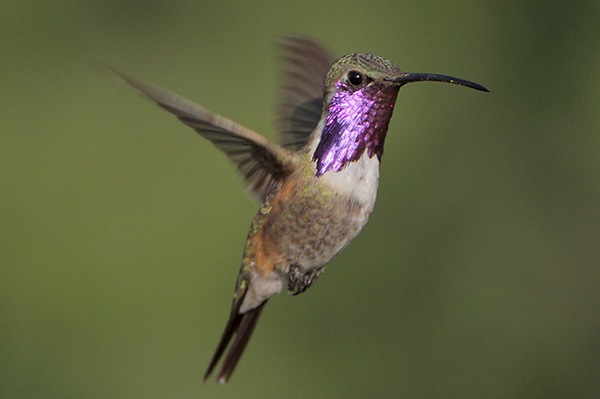
Scientific name: Calothorax lucifer
Length: 3.5 inches
Wingspan: 4 inches
Lucifer Hummingbirds are small, uncommon hummingbirds that mostly live in Mexico. In the USA, we only see this prize species in southeastern Arizona, and in the Big Bend area of western Texas.
Lucifer Hummingbirds have a long, curved beak, and buff and green underparts. Males also have a beautiful, long, shining red-purple throat patch and a dark, forked tail. Females, on the other hand, have a plain, buffy throat, buffy line behind their eyes, and orange on the base on their broad tails.
These special little hummingbirds can be hard to see because they often live in remote desert habitats. Even there, they can be local as they move around in search of flowering agave and other desert plants.
Luckily, they sometimes visit feeders too! After breeding, Lucifer Hummingbirds migrate to central and southern Mexico. The “Lucifer” part of this bird’s name means “light bearing” and is associated with the bright shining color of the male’s throat.
Key identifications:
- Long curved beak.
- Males have a long, red-violet throat patch and forked tail.
- Females have a buffy line behind their eyes and on their chest.
Calliope Hummingbird
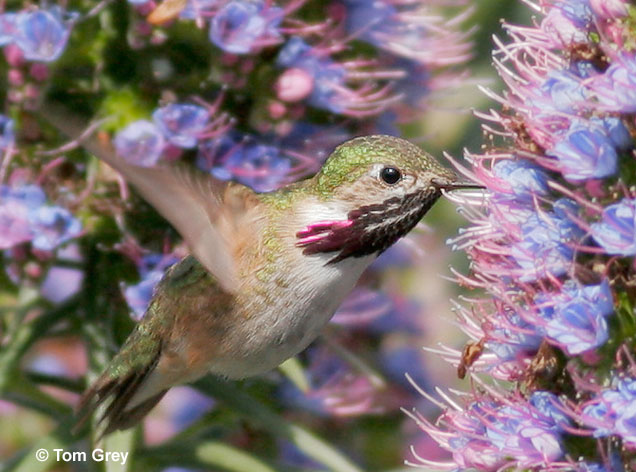
Scientific name: Selasphorus calliope
Length: 3.25 inches
Wingspan: 4.25 inches
Calliope Hummingbirds have the distinction of being the smallest bird in North America. These feathered sprites are green above, pale buffy or pale greenish below, and have a short, squared tail.
They also have shorter, straighter beaks than other hummingbirds and a pale mark behind each eye. Male Calliopes have rose-red streaks on their throats while females have fine, dark streaking.
Calliope Hummingbirds breed in open coniferous woodlands from British Columbia to Utah and parts of central California. During summer and migration to and from Mexico, we can see Calliope Hummingbirds at flowering bushes and feeders.
They can also show up at feeders well east of their range and have become annual visitors to Florida and some other places. Perhaps to avoid being chased away by other, larger hummingbirds, Calliopes are pretty quiet and good at keeping out of sight.
If you see a tiny hummingbird suddenly sneak into the feeder, it could be a Calliope!
Key identifications:
- Small hummingbird with a squared tail and straight, fairly short beak.
- No rufous in its tail.
- Streaked throat.
Allen’s Hummingbird
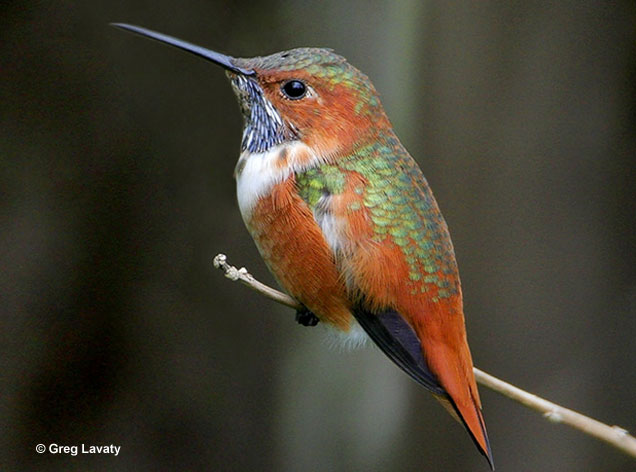
Scientific name: Selasphorus sasin
Length: 3.75 inches
Wingspan: 4.25 inches
The Allen’s Hummingbird is one of the key hummingbird species of California. Except for a small part of Oregon, this pretty little bird mostly breeds in coastal scrub in The Golden State.
In addition to their breeding range, we can recognize Allen’s Hummingbirds by their orange underparts and tail, and green upperparts. Males have a beautiful red-orange throat patch while females have bits of red-orange and green spotting on their throat.
Females also have orange on their rump and the base of their tail. Both sexes have a pale spot behind their eyes, white chest, and a slightly curved beak.
In their breeding range, Allen’s Hummingbirds are pretty easy to see. They like to forage at flowering bushes and also visit feeders. Like other hummingbirds, they also catch small insects in flight.
After breeding, Allen’s Hummingbirds migrate to a fairly small area in the mountains of central Mexico.
Key identifications:
- Orange underparts, green upperparts, and long, pointed tail feathers.
- Males have a red-orange throat.
- Females have a pale orange eyebrow.
Broad-billed Hummingbird
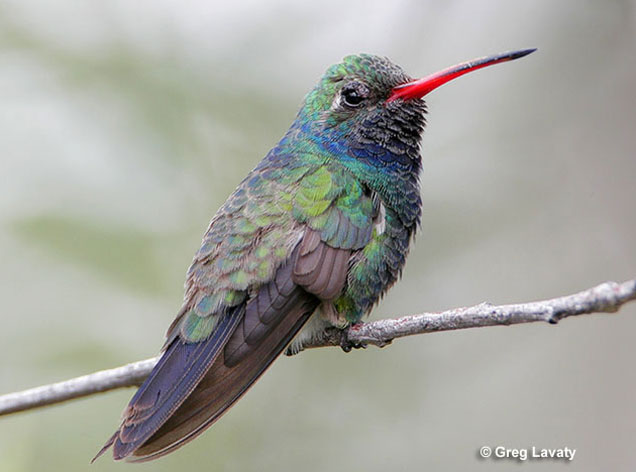
Scientific name: Cyanthus latirostris
Length: 4 inches
Wingspan: 5.75 inches
The Broad-billed Hummingbird is a small to medium-sized, distinctive hummingbird with green upperparts, a broad, forked tail, and a red beak with a dark tip. Males also have a violet-blue throat, and dark, blue-green underparts.
Females have grayish underparts, a white line going back from their eyes, and a dusky mask.
Broad-billed Hummingbirds occur from southeastern Arizona and adjacent New Mexico to Mexico. In the USA, they mostly live along streams on canyons. However, further south, we also see this hummingbird species in a variety of subtropical and tropical habitats.
Most of the birds that nest in the USA migrate south for the winter. However, some Broad-billed Hummingbirds have learned to migrate east to Louisiana and Florida.
Like some other western hummingbirds, they go there to take advantage of the many hummingbird feeders. This species is usually bold and easy to see, especially at feeders. However, they can also forage at a wide variety of flowering shrubs.
Key identifications:
- Dark blue-green underparts.
- Red beak with a dark tip.
- Females have dingy gray underparts and a pale line going back from their eyes.
Rivoli’s Hummingbird

Scientific name: Eugenes fulgens
Length: 5.25 inches
Wingspan: 7.5 inches
Rivoli’s Hummingbirds are one of the most spectacular hummingbirds in the USA. These big, beautiful hummingbirds have long, needle-like beaks, and are as big as a warbler!
Males are green above, black below, have a big, broad tail, and a small white spot behind each eye. In dim lighting, their head can look black but when the light hits it, they show a beautiful amethyst crown and a stunning berylline green throat!
Females aren’t nearly as colorful. They are green above, dusky gray-green below, have a white line going back from their eyes, and a white line from their chin to the lower side of their face.
Rivoli’s Hummingbirds mostly live in Mexico and northern Central America. However, some also breed in the mountains of southeastern Arizona and adjacent New Mexico.
In those areas, they are pretty common and easy to see as they forage at flowering bushes and feeders.
Key identifications:
- Big hummingbird with a long beak.
- Males a small white spot behind their eyes and have black underparts.
- Females have a green rump, a white line going back from their eyes, and a white line on the lower part of their face.
Blue-throated Mountain-gem
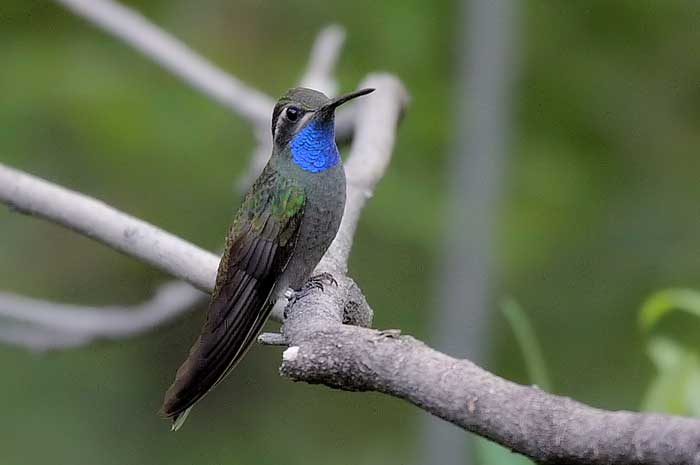
Scientific name: Lampornis clemenciae
Length: 5 inches
Wingspan: 8 inches
Blue-throated Mountain-gems are big, beautiful hummingbirds with a white line behind their eyes, white line on the lower part of their face, and a bronzy rump. The rest of their upperparts are green, and both sexes have gray underparts.
Males also have a shining blue throat, and both sexes have big white spots on the corners of their dark tails.
These big hummingbirds live in streamside forests in the mountains of southeastern Arizona, and in some other parts of Arizona, New Mexico, and western Texas. They also live in the mountains of Mexico, and birds that breed in the USA winter there.
Blue-throated Mountain-gems take nectar from understory plants, are regular at feeders, and commonly nest in sheds and other structures. Fortunately, these fun hummingbirds are pretty easy to see. They can be hard to miss; the Blue-throated Mountain-gem is the biggest hummingbird species in the USA!
Key identifications:
- Big hummingbird with gray underparts.
- Males have a blue throat.
- Both sexes have a big, dark tail with white corners.
Costa’s Hummingbird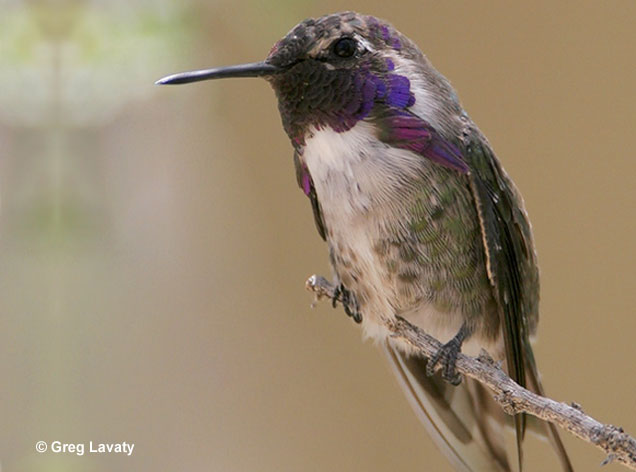
Scientific name: Calypte costae
Length: 3.5 inches
Wingspan: 4.75 inches
Costa’s Hummingbirds are small hummingbirds of the southwestern deserts. These little hummingbirds are one of the more common hummingbirds in arid habitats of southern California, western and southern Arizona, and parts of Nevada and Utah.
This species also occurs in northwestern Mexico and some birds also migrate there for the winter.
These beautiful little birds are pretty easy to see in gardens and all sorts of desert habitats, especially at flowering plants. Luckily, Costa’s Hummingbirds are also common visitors to hummingbird feeders.
Males are beautiful little birds with deep, shining purple on their heads, and on their long throat patches. They are also green above, have dusky green on their belly, and a small white eyebrow.
Females are plainer with green upperparts, mostly white underparts, and a bit of white above and behind their eyes. Both sexes also have a short tail, and shortish, slightly curved beaks.
Key identifications:
- Small hummingbird with a short tail and fairly short bill.
- Males have a beautiful, long purple throat patch.
- Females have whitish underparts, and a small pale eyebrow.
White-eared Hummingbird
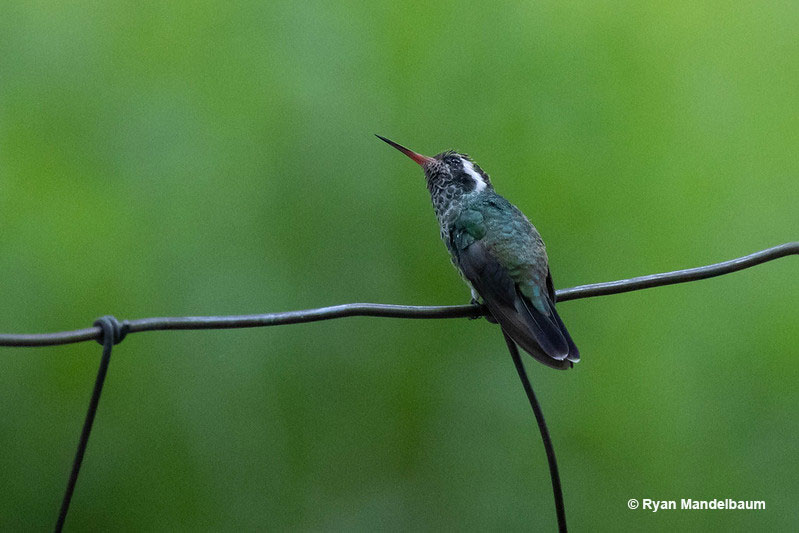
Scientific name: Basilinna leucotis
Length: 3.75 inches
Wingspan: 5.75 inches
White-eared Hummingbirds are common hummingbirds in Mexico and northern Central America. They live in all sorts of montane habitats where they forage on flowering bushes and other plants.
Each summer, some White-eared Hummingbirds also range into the mountains of southern Arizona, New Mexico, and western Texas. Although lucky birders might find these rare birds in forested canyons, most see them at feeder set-ups.
Sometimes, you can also find these special hummingbirds by listening for the sharp metallic chip notes they make.
White-eared Hummingbirds have bright red beaks with a dark tip, and broad, dark tails. Their “white ears” are a thick white line that goes back from each eye.
Male White-eared Hummingbirds are mostly dark green with some white on their belly, and have blackish heads with some dark green on their throat. Females have a black mask, and green spotting on their pale underparts.
Key identifications:
- Red beak with a dark tip.
- Broad white line on the back part of its face.
- Male has a black and dark green throat, female has green spotting on her underparts.
Frequently Asked Questions
How many hummingbird species does Texas have?
Texas has 19 species of hummingbirds! However, seven of those hummingbird species are rare visitors to the state.
Do any hummingbirds live in Texas year-round?
Yes, one hummingbird lives in Texas year-round. The Buff-bellied Hummingbird is a permanent resident in southern Texas.
Do hummingbirds need feeders in Texas?
No, hummingbirds don’t need feeders in Texas. However, feeders can provide them with much needed food.
What is the rarest hummingbird you can see in Texas?
The rarest hummingbird you can see in Texas is the Amethyst-throated Mountain-gem. This Mexican species has only occurred in western Texas on one occasion.
Discover more about Texas: Most common birds | Hawks | Owls | Ducks | State Bird

